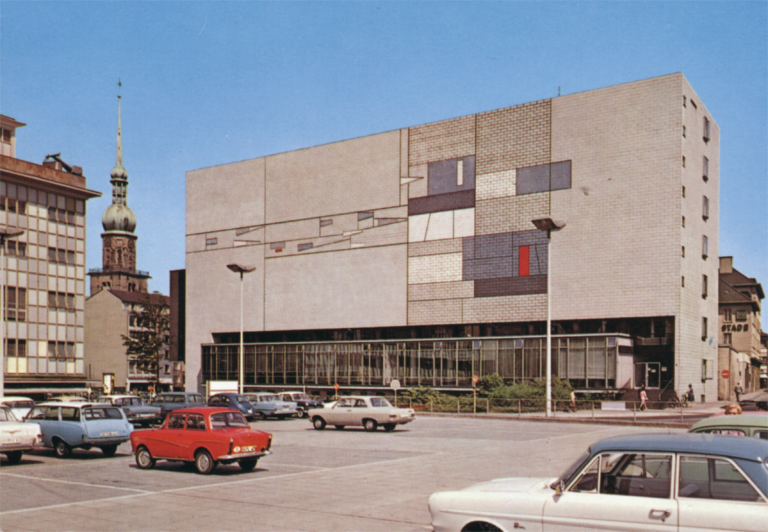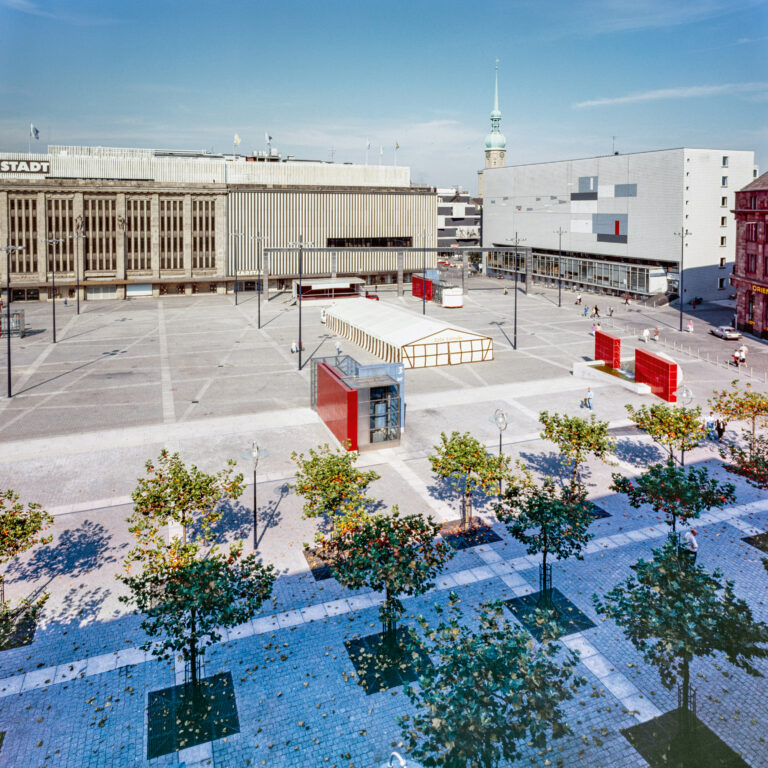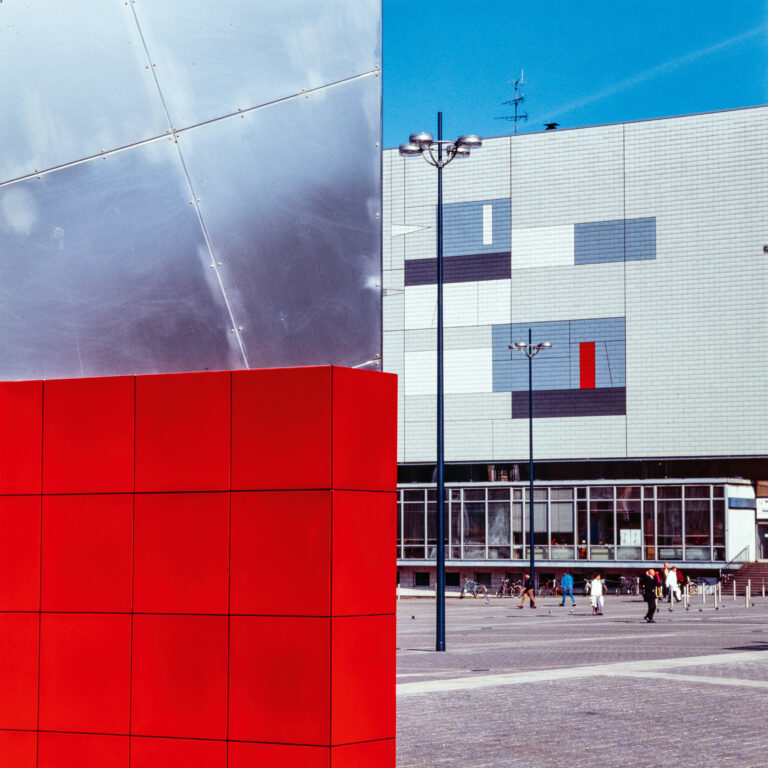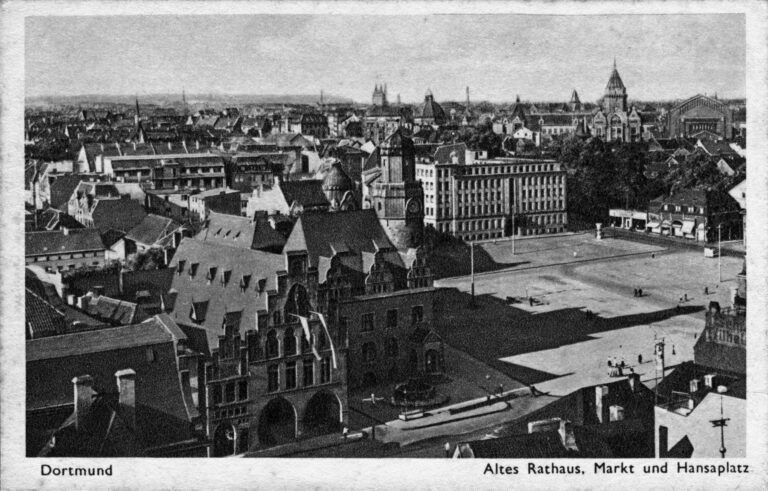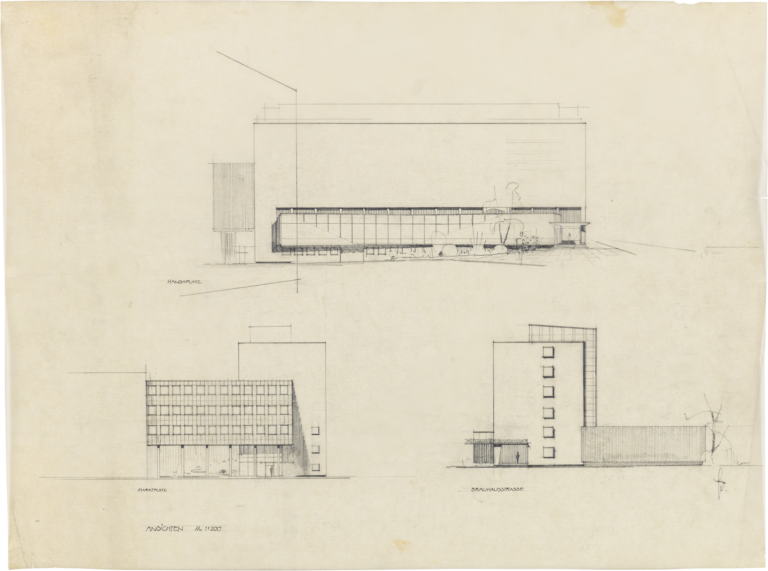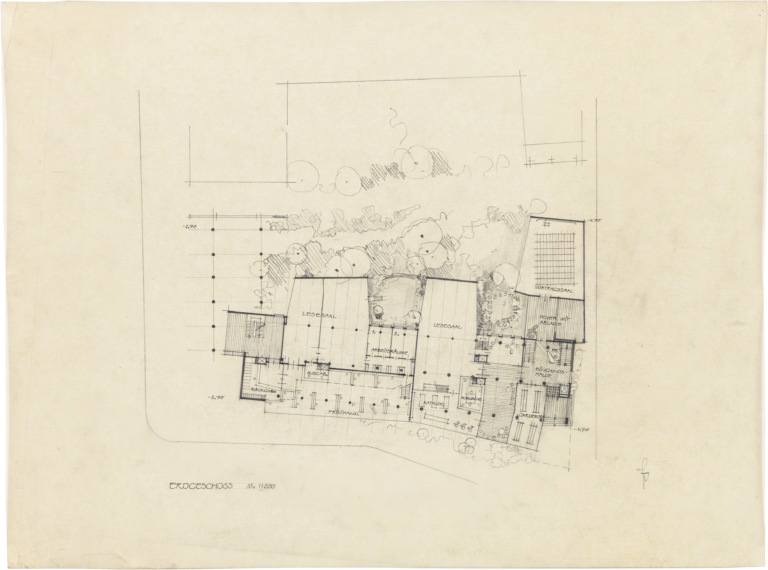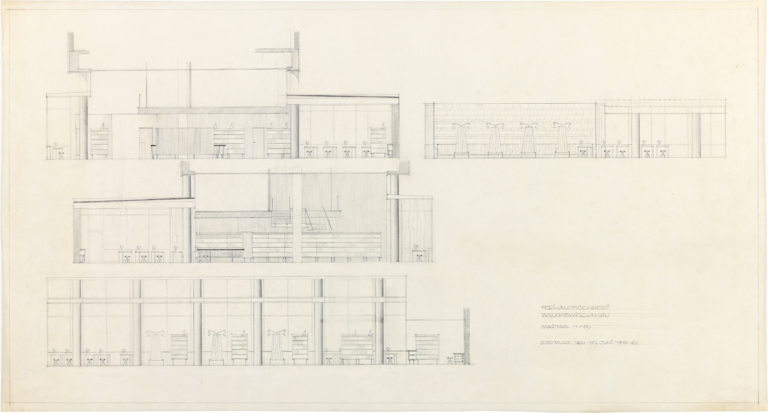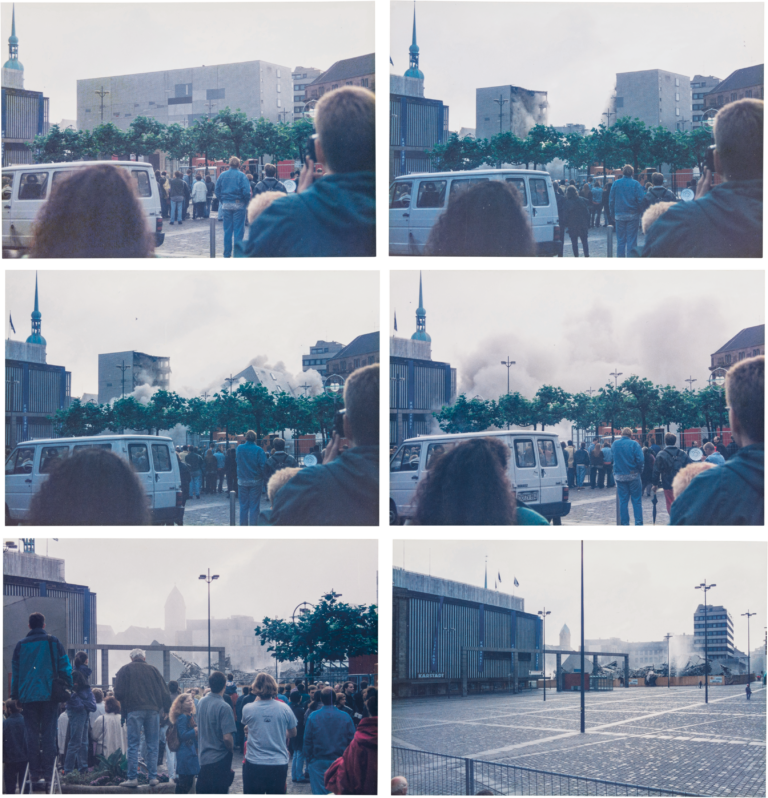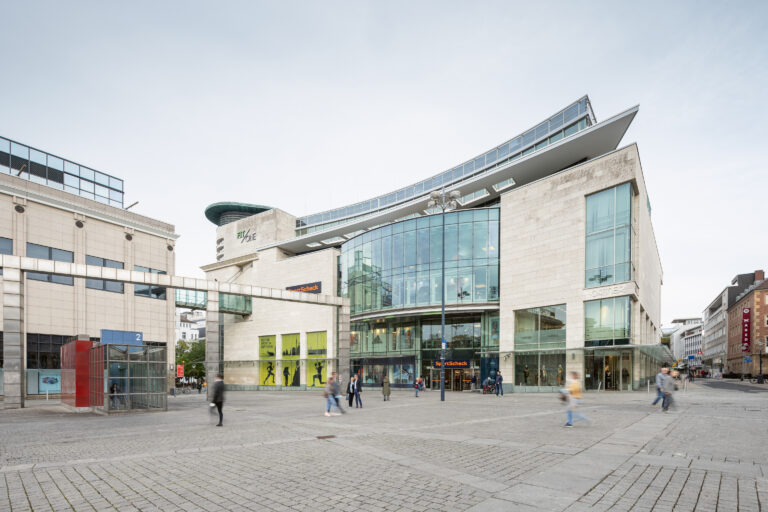Between two squares
Christin Ruppio, Christos StremmenosHansaplatz in Dortmund is the largest public square within the historic city centre defined by the old medieval ramparts. This location, with its expansiveness characteristic today of an urban space, is the result of a process of transformation that commenced at the beginning of the 20th century. The Hanseatic city’s historic marketplace – the adjacent Alter Markt – became too small for the expanding trading activities. In 1903, the meat traders were the first to move their stalls to the site of today’s Hansaplatz, a space only created by the gradual demolition and clearance of a historic quarter. This urban redevelopment, prompted mainly by the demands of commerce and accomplished in several stages, not only resulted in the loss of historic building fabric, but also went hand in hand with the straightening of the winding streets and irregularly shaped spaces of the historic city layout.
The city’s main market
The construction of multi-storey buildings – such as the National-Bank completed in 1906 on the corner plot of Wißstrasse/Brauhausstrasse and the extension of the Althoff department stores’ realised in 1912 – introduced the metropolitan scale on the perimeter of the new generously dimensioned square. The open space that expanded in the course of this transformation process provided room for market activities, which eventually shifted from the Alter Markt to the newly created square. Thus, Hansaplatz not only defines the largest inner-city square, but has since been home to the city’s main market. But these two important urban squares are not only linked by the relocation of the main market activity. The bottleneck at the transition from one square to the other also underwent structural accentuation in the course of urban redevelopment and linked the two sites with institutions of cross-city relevance.
Mediator between the two squares
The monumental Historicist building erected in 1908 by the city architect Kullrich on the corner of Alter Markt and Hansastrasse to the right of Dortmund’s old town hall housed the Stadtsparkasse municipal savings bank on the ground floor. The library, which had already been founded in 1907, moved into the newly built rooms on the upper floor – together with the central public library.
For almost a century, the history of the city library was to be closely interwoven with that of the location as a mediator between the two squares. The municipal savings bank building was given over entirely to library use when the bank moved out in 1924. From then on, the library as an institution was also associated with an example of striking architecture. The stone building, however, like many other surrounding structures, did not survive the bombing of the Second World War. Along with it, an extensive collection of books was irretrievably lost.
A new, central library
The reconstruction plans after the severe destruction during the Second World War resorted primarily to the contours of urban renewal drawn in the pre-war period. Among the key activists in the reconstruction period was the architect Walter Höltje, who had already had a large hand in the comprehensive new plans for Dortmund’s city centre from 1948 to 1950. In the immediate post-war period, efforts were also made to bring together new book collections and to think about a new, central library building. These plans became more concrete in 1954 with the announcement of a competition for a new library building. Coming first and second, Walter Höltje and Karl Walter Schulze realised the building together from 1956 to 1958.
History of the site
Although Höltje later claimed he had not followed earlier designs for urban renewal, ideas from the period between 1914 and 1930 can nevertheless be traced in the reconstruction and remodelling plans of the post-1945 period. The House of Libraries (Haus der Bibliotheken) was built on the site of the old municipal library at the juncture of Alter Markt and Hansaplatz and thus refers to the history of the site before the Second World War.
An undated sheet in Walter Höltje’s estate shows three views of the building: at the top, the west façade facing Hansaplatz with a closed-stack section and glazed open-stack area; at the bottom left, the north façade dominated by the three-storey administration building on columns; and at the bottom right, the south façade.
A light-flooded shared space
In their design, Höltje and Schulze relied above all on the effect of the elongated block, which, firstly, mediated between the two squares and, secondly, overlooked Hansaplatz with its main façade. The view from Hansaplatz would also prove to be the most lasting image of the library imprinted in the city’s memory: a long, horizontally structured solid block with a tile mosaic, from which a showcase-like glass body protruded along the entire length of the building at ground level. The switch from solid to transparent structures can be deduced from the use of the building. While the closed areas primarily ensured the conservation of the book collections in the stacks, the glazed open-stack area with reading places in particular opened onto Hansaplatz as a light-flooded shared space.
Complex building structure
However, Höltje and Schulze focused not only on creating this striking image. For they also sought to respond to the various urban situations with a complex building structure and to create addresses at the various urban outlines that they built over. The ground floor plan clearly shows the division of the building into two parts. The glass body, which from Hansaplatz seems continuous, is divided in two within. A kink in the glass façade discreetly suggests this division. The north side housed the public library, while the south side housed the municipal and Land library. This separation also required two separate entrances to the two libraries, which created addresses at the two neighbouring squares: the public library with its own entrance from the Alter Markt; the municipal and Land library accessed via the open staircase next to the “glass showcase” at Hansaplatz.
Two libraries
In addition to these two libraries, the building also accommodated the Westphalian-Lower Rhine Institute for Newspaper Research as well as the administrative offices belonging to the three institutions. The reading rooms of the two libraries also projected into the inner courtyard situation delimited by the two blocks of the building. These transparent areas, which emerged in a freer form from the main block’s rectilinearity, provided quiet workplaces with a view of a landscaped courtyard. The architects’ intention to design an open-stack area that, extending over two levels, is as open and transparent as possible, can be clearly seen in the wall developments drawn in pencil on tracing paper.
Tile mosaic
Furnishings and fittings such as bookshelves, desks equipped with architect’s lamps and three-legged swivel stools have the air of everyday furniture in their functional simplicity and lightweight design that responds to human scale and creates an atmosphere of contemporary homeliness. The monumentality of the seven-storey stack section was also mitigated towards Hansaplatz by a tile mosaic by the artist Klaus Gerwin. Although the mosaic’s constructivist composition echoes the austerity and clarity of the building, its subtle colour shades and varying sizes of the geometric shapes invite the eye to wander across the façade instead of becoming transfixed, as it were, by a continuous surface. Although the tile pattern gave the building its characteristic face, it also made the building a growing talking point from the 1980s onwards, as it was evidently in a state of disrepair.
Rediscovery
Hansaplatz, the square serving the building, also lost its appeal after Dortmund’s car-oriented urban redevelopment in the years of reconstruction after the Second World War. The largest inner-city square was transformed into the largest area of parking space in the historic centre. The square’s promise of generating places of rest and activity accessible to pedestrians yielded to an enthusiasm for the automotive development of urban places. The extensive use of the square as a car park in the 1980s seemed to segregate it from the buildings that spatially defined it. The advancing degradation of the façades was remedied by an extensive refurbishment of the building by the architects Harald Meißner and Nicola Fortmann-Drühe from 1988 to 1990. But, with their restoration work, the two architects not only rescued the building’s face, for they also contributed to the revitalisation and rediscovery of Hansaplatz.
Redevelopment of Hansaplatz
In their competition entry for the redevelopment of Hansaplatz, submitted in 1987 and realised in 1991, they recognised the site’s predicament and the neglect of its public character. Their design envisaged the recovery of the square for pedestrians and the relocation of vehicle parking underground. An urban carpet was laid out over the expansive urban space up to the townhouses surrounding the square in order to reunify the segregated units. Using two overlapping paved grid structures, an attempt was also made to geometrically interweave the sites through the stone carpet. The main grid, for example, takes its cue from the rectangularity of Hansaplatz accentuated by the above-mentioned transformation process at the beginning of the 20th century; a second, more discreetly formulated grid with the same mesh size laid across the square appears to have been twisted out of the main grid and references the angular historical building lines such as in Wißstrasse, which leads into the square, or the at the time diamond-shaped paving of the Alter Markt.
Colour scheme
The reference to the place was also visible elsewhere. Meißner and Fortmann-Drühe accentuated the importance of the library for the square. With coloured, slab-like elements placed in the square and referring to Gerwin’s two-dimensional composition, they not only created a structure for the expansiveness and the organised social spaces, but also used them to playfully stage the entrances to the underground car park. The coloured slabs positioned in a staggered arrangement in the square looked as if they had been detached from the tile mosaic of the library façade and gain three-dimensionality in the square. This impression was enhanced by using the same colour scheme. Colonnades scaled to the dimensions of the transparent reading room projecting into the public space also suggested a gateway situation from Hansaplatz to Alter Markt and cited the historical interweaving of the two places in a postmodern manner.
New requirements
At the time of its construction, the House of Libraries was praised in professional journals for successfully reconciling the practical demands of a library with the representational needs of democratic post-war Germany, but in the course of time, the demands changed. The House of Libraries became too small for the new requirements, and the building’s structure hampered the integration of installations necessary for modern library operations. With the growing number of academic libraries established in the Ruhr region, the Land library tasks fell away, and rationalisation due to cost-cutting measures also ultimately led to the decision to merge the public library with the municipal and Land library and to create a modern library facility in a new building at the main railway station.
Demolition
Repurposing proved difficult because the House of Libraries was designed to meet the very specific demands of library operations and the bookshelves, for example, were load-bearing components of the structure. For almost forty years, the House of Libraries had been one of the city’s landmark structures and an inner-city hub, but many local residents came to reject its preservation owing to its increasing dilapidation and severe degradation. Although there were protests shortly before the decision to pull down the building in 1996, its demolition could not be prevented.
Department store and square design
The great interest in its demolition can also be observed in another of the holdings of the architecture archives: the architects Mechtild Gastreich-Moritz and Ulrich Gastreich – who had themselves contributed to the face of the “New Dortmund” of the post-war period with the pavilions at the main station and had witnessed the demolition of these buildings in 1995 – photographed demolition and kept these pictures. The demolition of the pavilions at the main station ultimately made way for a new building by Mario Botta. At the site of the old House of Libraries, nothing today reminds us of this urban landmark. A department store has been built in its place. Only the slab-like elements from Meißner and Fortmann-Drühe’s square design have remained on Hansaplatz and quote the mosaic of the House of Libraries.
The present text was first published in: Hans-Jürgen Lechtreck, Wolfgang Sonne, Barbara Welzel (ed.): Bildung@Stadt_Bauten_Ruhr, Dortmund 2022, pp. 262–277.
